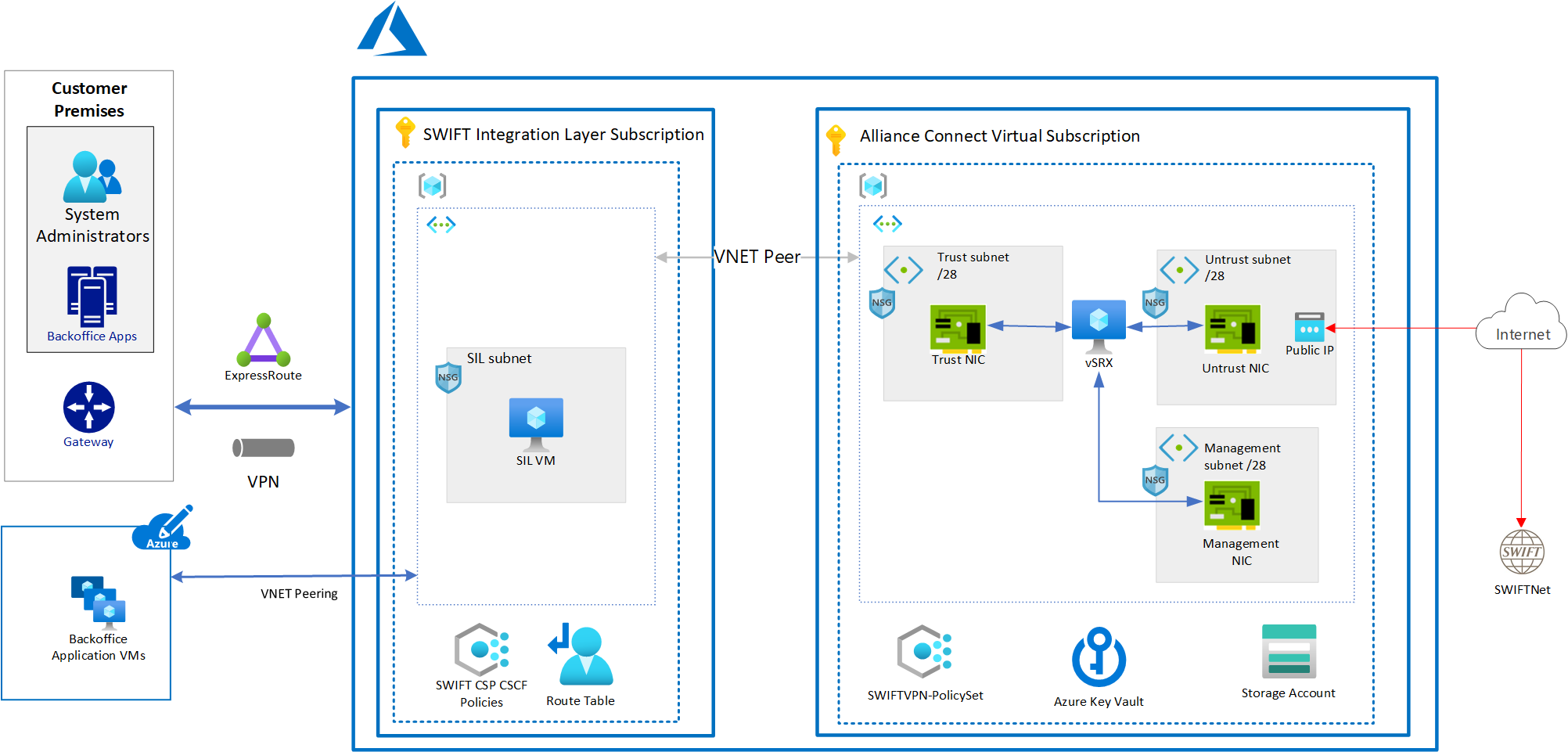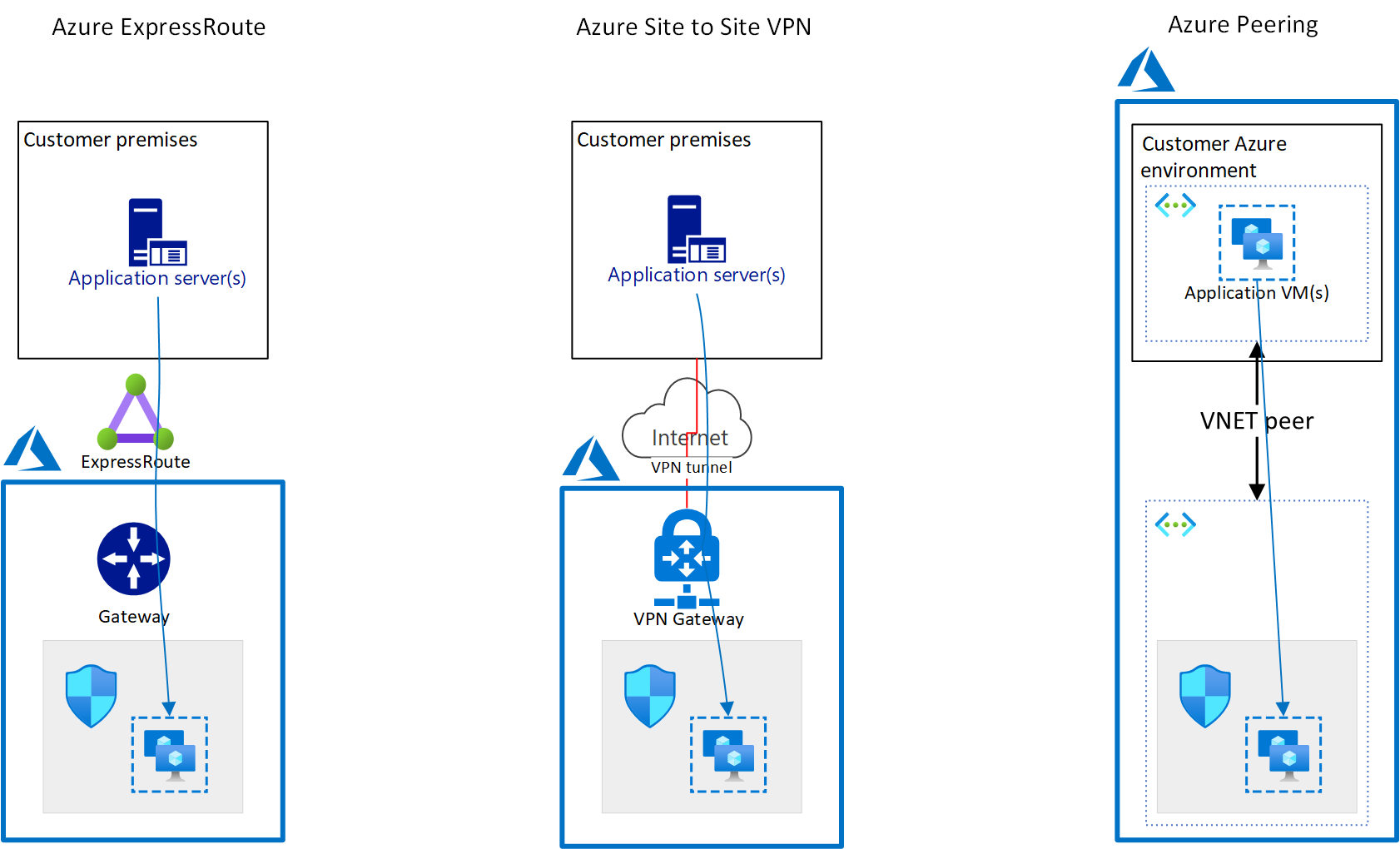Note
This article provides an overview with reference architecture for deploying SWIFT's Alliance Connect Virtual solution on Azure. Please note that the new Alliance Connect Virtual solution is not yet available for SWIFT production traffic. The solution is currently being tested with SWIFT customers and will become generally available throughout 2022 as part of a phased launch. For more information about the general availability of the product, see SWIFT.com.
This article provides an overview of deploying Alliance Cloud connectivity stack in Azure. The solution requires two Azure subscriptions. One subscription contains the SWIFT Integration Layer (SIL) resources. The other subscription contains the resources to connect to SWIFT's network via Alliance Connect Virtual.
This approach can be used for:
Potential use cases
This solution is targeted to:
- Existing SWIFT customers who run SIL on premises and want to run Alliance Cloud in Azure.
- New SWIFT customers who can benefit by deploying directly to Azure.
Architecture

Download a Visio file that contains this architecture diagram.
Workflow
In this example scenario, deployment of SWIFT's Alliance Cloud in Azure involves using two Azure subscriptions. The two-subscription design separates resources based on the primary responsibility for each resource:
- SWIFT customers are primarily responsible for supplying the resources for the SIL in one Azure subscription.
- SWIFT provides the virtual firewall, Juniper vSRX, as part of the solution for managed connectivity of Alliance Connect Virtual in another Azure subscription.
In this context, SWIFT configures the Juniper vSRX and establishes the VPN tunnel from the Juniper vSRX to SWIFT. Customers have no access nor visibility into the Juniper vSRX configuration or operation, but customers do have visibility and operational responsibility for the underlying Azure infrastructure resources.
The footprint of SWIFT's Alliance Cloud is based on a single tenant. To increase resiliency and availability, each customer deploys a second similar configuration, in standby mode, in a different Azure region. For each customer, there's an instance of the SIL and Alliance Connect Virtual.
The SIL subscription contains resources that are managed by the customer. The SIL subscription has a single resource group, which contains:
- An Azure virtual network.
- An Azure subnet for Azure Firewall with an Azure network security group.
- An Azure subnet for the SIL with an Azure network security group
- A configuration of Azure Firewall that allows appropriate traffic to SIL.
- Azure policies for compliance with SWIFT's Customer Security Programme (CSP) – Customer Security Controls Framework (CSCF).
The resources for the SIL can be deployed by using an Azure Resource Manager template (ARM template) to create the core infrastructure, as described in this architecture. You can modify the ARM template for the SIL to meet your specific needs as long as the configuration adheres to policies that are required by CSP–CSCF. You can use Azure Policy to apply the necessary policies to comply with CSP–CSCF.
The Alliance Connect Virtual subscription contains resources that you deploy. You deploy them by using an ARM template, also known as the Cloud Infrastructure Definition (CID) file, that's provided by SWIFT. SWIFT manages the configuration and operation of the Juniper vSRX.
SWIFT customers establish secure connectivity to the SIL subscription by:
- Using ExpressRoute to connect on-premises resources to Azure via private connectivity.
- Using site-to-site VPN to connect customer premises to Azure via the internet.
- Using Remote Desktop Protocol (RDP) over the internet to connect customers that have internet connectivity.

The SWIFT customer uses one of the three methods of connectivity to connect to the SIL software that runs on the SIL VM. The recommended configurations of Azure Firewall and network security groups allow only appropriate traffic to pass to the SIL VM. The traffic from the SIL software to SWIFTNet flows via the virtual network peering with the Juniper vSRX, which has an established VPN tunnel to SWIFTNet over the internet.
Components
- Azure Bastion is a fully managed service that provides secure and seamless RDP and SSH access to VMs without any exposure through public IP addresses.
- Azure ExpressRoute extends your on-premises networks into the Microsoft cloud over a private connection that's facilitated by a connectivity provider. You can use ExpressRoute to establish connections to Microsoft cloud services like Azure and Office 365.
- Azure Firewall enforces application and network connectivity policies. This network security service centrally manages the policies across multiple virtual networks and subscriptions.
- Azure Policy helps you to manage policies in a central location, track compliance status, govern resources, and discover the changes that made a resource non-compliant. By using Azure Policy, you can enforce policies on your resources and ensure that future configurations are compliant with standards and regulations.
- Virtual Network is the fundamental building block for private networks in Azure. Through Virtual Network, Azure resources like VMs can securely communicate with each other, the internet, and on-premises networks.
- Virtual Machines is an infrastructure-as-a-service (IaaS) offering. You can use Virtual Machines to deploy on-demand, scalable computing resources. Virtual Machines provides the flexibility of virtualization but eliminates the maintenance demands of physical hardware.
Considerations
You can engage your account team at Microsoft to help guide your Azure implementation for SWIFT.
Segregate different environments
SWIFT customer resources on Azure should comply with CSP–CSCF. CSP–CSCF control version 1.1 mandates segregation between different environments, like production, test, and development. We recommend that you deploy each environment in a separate subscription. Separate subscriptions make it easier to segregate servers and other infrastructure, credentials, and so on.
Availability
This example scenario for SWIFT's Alliance Cloud and SIL doesn't provide high availability. However, you can deploy multiple instances of SIL and Alliance Cloud to support higher availability by providing back-up locations for SWIFT users.
Operations
- Works With All Liquid Hand Soaps
- Plays 20 Second Song That Teaches Children How To...
- Motion Sensor Technology Provides Sanitary,...
- Magnetically Attached Drip Tray Removes Easily For...
- Self-cleaning Function Prevents Clogs And Mess
- STYLISH CANE FROM THE RED CARPET TO YOUR HOME! Our...
- 100% SATISFACTION GUARANTEED! Buy with confidence,...
- EXCEPTIONAL COMFORT DUE TO ERGONOMIC HANDLE. The...
- CHOOSE THE CORRECT LENGTH TO AVOID SPINE PAIN....
- WIDE QUAD CANE TIP COMPATIBLE. Need extra...
Customers have responsibility for operating both the SIL software and the underlying Azure resources in the SIL subscription.
In the Alliance Connect Virtual subscription, SWIFT is responsible for the configuration of the Juniper vSRX and the operation of the VPN between the Juniper vSRX and SWIFTNet. The customer is responsible for operating and monitoring the underlying infrastructure resources.
Azure provides a comprehensive set of monitoring capabilities in Azure Monitor. These tools focus on the infrastructure that's deployed in Azure. Monitoring the SWIFT software falls outside these tools. You can use a monitoring agent to collect event logs, performance counters, and other logs, and have these logs and metrics sent to Azure Monitor. For more information, see Overview of the Azure monitoring agents.
Azure Alerts uses data from Azure Monitor to proactively notify you when issues are found with your infrastructure or application. They allow you to identify and address issues before the users of your system notice them.
Log Analytics in Azure Monitor allows you to edit and run queries with data in Azure Monitor Logs.
Security
The traffic between the SIL and the Juniper vSRX is limited to specific and known traffic. You can use network security groups and the packet capture capabilities that are provided by Network Watcher, and combined with Azure Security Center and Azure Sentinel. Network security group flow logs in Azure Network Watcher can be used to send flow data to Azure Storage accounts. Azure Sentinel can collect these logs, detect and investigate threats, and respond to incidents with built-in orchestration and automation of common tasks.
Azure Bastion enables connectivity transparently from the Azure portal to a virtual machine via RDP or Secure Shell Protocol (SSH). Because Azure Bastion requires administrators to sign in to the Azure portal, you can use Conditional Access to enforce multi-factor authentication and other access restrictions. For example, you can specify the public IP address from which administrators can sign in.
Azure Bastion requires a dedicated subnet to deploy to and requires a public IP address. Access to this public IP address is restricted by Azure Bastion through a network security group that's managed. Deploying Azure Bastion also enables just-in-time access, which only opens required ports on demand when remote access is required.
Enforce SWIFT CSP–CSCF policies
Azure Policy enables customers to set policies that need to be enforced within an Azure subscription to meet compliance or security requirements. For example, Azure Policy can be used to block administrators to deploy certain resources or enforce network configuration rules that block traffic to the internet. Customers can use built-in policies or create policies themselves.
SWIFT has a policy framework that helps you enforce a subset of SWIFT CSP–CSCF requirements by using Azure policies within your subscription. For simplicity, you can create a separate subscription in which you deploy SWIFT Secure Zone components and another subscription for other potentially related components. Separate subscriptions enable you to apply the SWIFT CSP–CSCF Azure policies only to subscriptions that contain a SWIFT Secure Zone.
We recommend deploying SWIFT components in a subscription that's separate from any back-office applications. Separate subscriptions ensure that SWIFT CSP–CSCF only applies to SWIFT components and not to customer-specific components.
- The natural look of agate stone creates a unique...
- The edges of each piece are electroplated (NOT...
- Handles are solid brass.
- Available in 12", 14" and 16" diameter
- Can do silver, rose gold, or gold plating for...
- The natural look of agate stone creates a unique...
- The edges of each piece are electroplated (NOT...
- Handles are solid brass.
- Available in 12", 14" and 16" diameter
- Can do silver, rose gold, or gold plating for...
- Sold as a set of 4 pieces
- 4" x 4"
- 10 - 12 mm thick
- Natural stone will vary in size, color, and...
- Each piece has 4 rubber pads to avoid scratching...
Consider using the latest implementation of SWIFT CSP controls in Azure after consulting with the Microsoft team that's working with you.
Pricing
To explore the cost of running this scenario, use the Azure pricing calculator, which preconfigures all Azure services.
Next steps
Explore the functionality and architecture of other SWIFT modules in the following articles:






